
At certain points during a construction project, contractors expect to get paid for their work. Whether it’s one bill at the end of the job or several smaller bills throughout its lifetime, these payments help the business keep the lights on, grow, and take on more jobs. Having a reliable, comprehensive construction invoice template gives your accounts receivable process the foundation it needs to make billing as smooth as possible.
Free Construction Invoice Templates
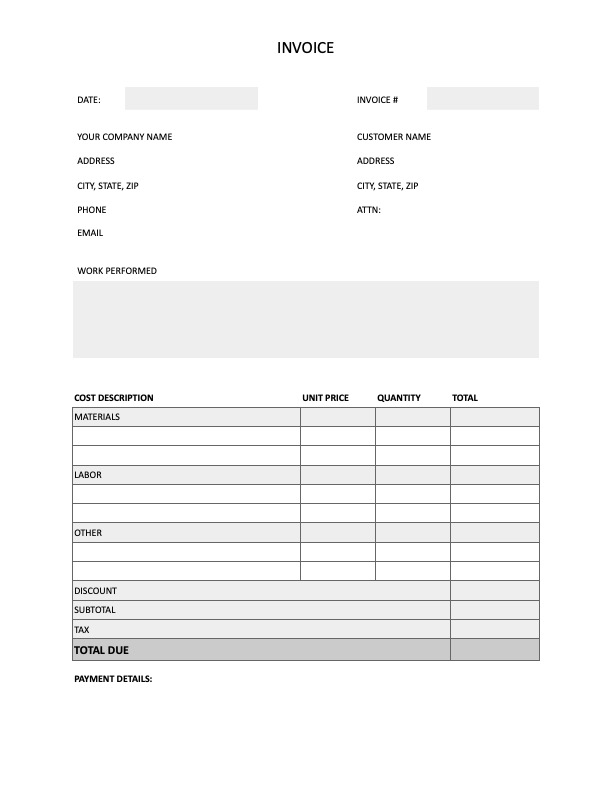
Basic Construction Invoice Template
This free general template was designed for use on small construction projects.
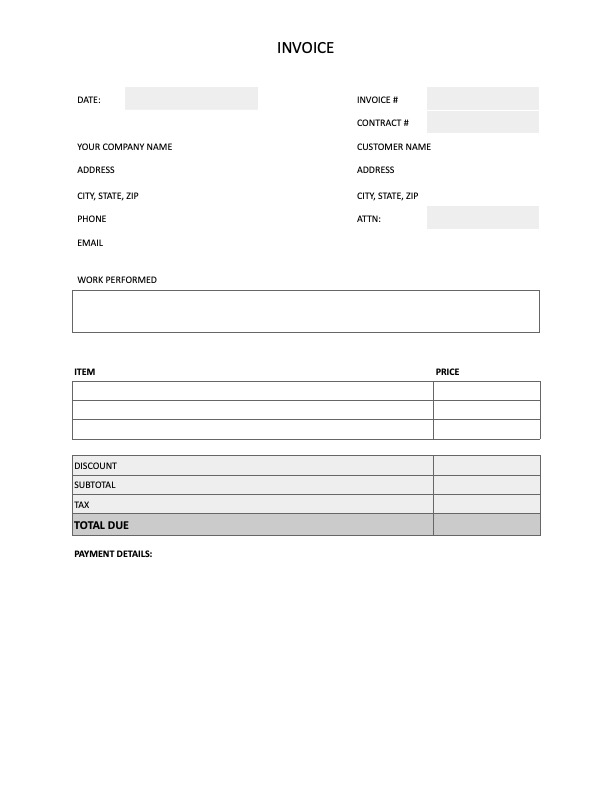
Lump Sum Contract Invoice Template
This free invoice template was designed for use on construction projects where you are working under a lump sum contract.
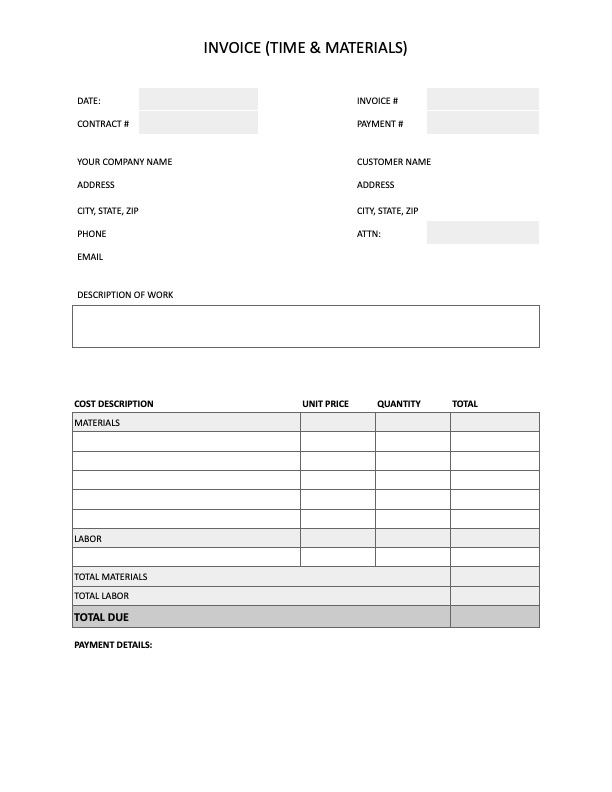
Time & Materials Contract Invoice Template
This free invoice template was designed for billing on projects where you are getting paid for time and materials. Learn more about T&M contracts.
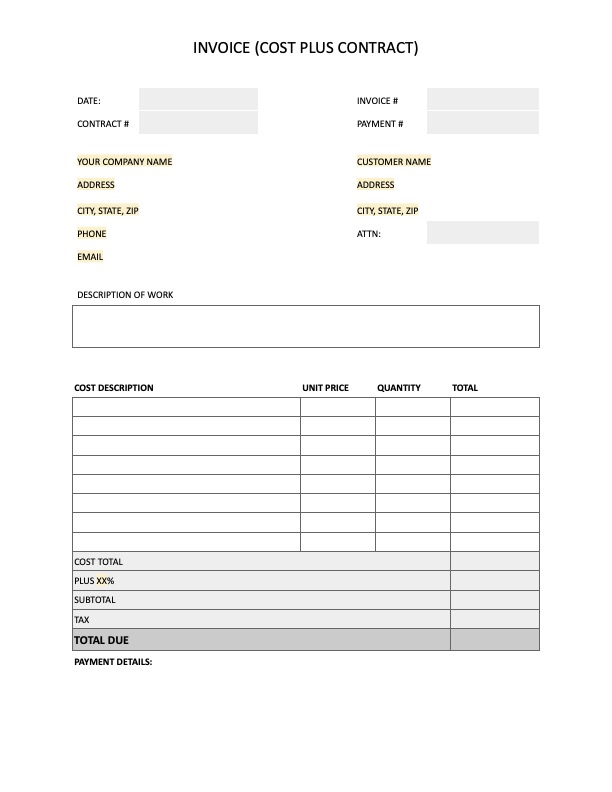
Cost Plus Contract Invoice Template
This free invoice template can be used on projects where you are working under a cost plus contract.
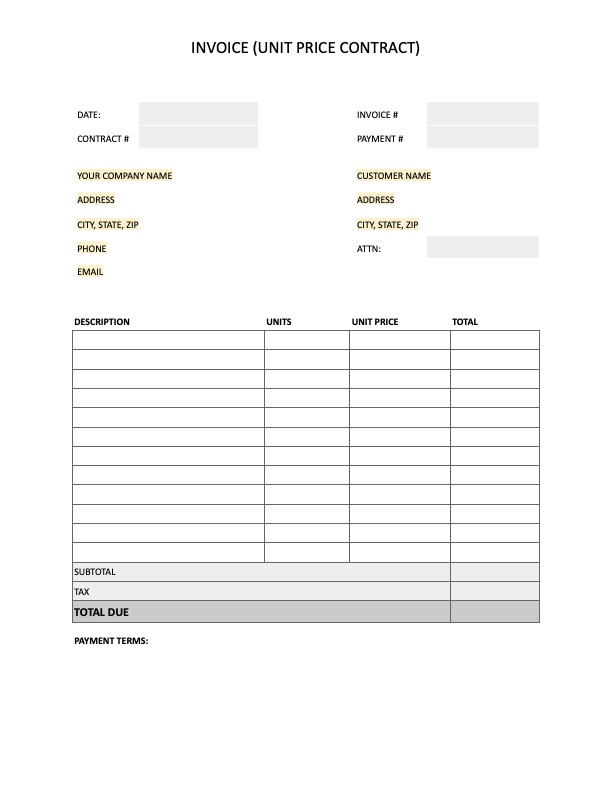
Unit Price Contract Invoice Template
Download this free invoice template for use on construction jobs using unit price contracts.
Elements of a Construction Invoice
When it comes to billing for your work, your construction invoice should be bulletproof. It needs to contain certain information to ensure it reaches the right people and leaves no room for doubt or mistakes. If you’re developing your own construction invoice template, be sure it includes the following critical elements.
Your Information
First, be sure that your customer knows exactly who is sending the invoice. The construction invoice template needs to include your business name, address, and contact information, like email and phone number.
The Date
Don’t underestimate the importance of including the date on your invoice template. The customer may see it as the mark of urgency, prompting them to pay sooner rather than later. Also, this date will be used to determine late fees and interest when applicable.
Invoice Number
Some accounts payable departments won’t accept an invoice without an invoice number. It’s a simple addition and can keep your invoice from getting kicked back after sitting on a desk for a few weeks.
Project Information
Including an area on the template for project information seems basic. But if you consider that general contractors, real estate developers, and project owners might be running 3 or 4 jobs at one time and from different bank accounts, the name and address of the job site can be critical to getting paid quickly.
Customer Information
In cases where the customer information might be different than the project information, be sure to include it on the construction invoice template. If there is a specific person that needs to receive it, call attention to their name on the invoice.
Work Performed
Project owners and GCs receive invoices all the time, so be sure they understand what they’re paying for by explaining the work performed. You don’t have to get too into the weeds on this point, but give a brief description of the work for which you’re billing. The labor and materials in the following sections will explain further.
Materials
When it comes to breaking the invoice down into the nitty-gritty details, you’ll need to include a section for materials. Include a column for the description of the material, a column for the individual price, and a column for the quantity. Finally, include a column tallying the price times the quantity.
For lump sum and unit price contracts, these columns might change. Lump sum and unit price are less concerned with individual materials and more concerned with overall amounts and percentages.
Labor
For the sake of transparency, include a labor breakdown in your construction invoice template. Include a column for each of the following: the labor description, the rate per hour, the number of hours, and the total.
Again, lump sum and unit price contracts aren’t concerned with labor costs. However, cost-plus contracts also care little about labor, so it’s okay to remove this section.
Other
Be sure to include a section for other expenses you plan to bill for. Equipment rentals, parking fees, and other miscellaneous job expenses usually won’t fall under materials, so the “other” section is where the construction invoice template should list them. Include the description, amount, quantity, and total.
Note: This will look different for lump sum, unit price, and cost-plus contracts.
Totals
A construction invoice template needs a section to tally up the materials, labor, and other costs into one final amount. This section should include the subtotal, any discounts (if applicable), the subtotal with the discounted amount subtracted, the tax amount, and the final balance. For cost plus contracts, include the cost total, as well as the agreed-upon plus percentage.
This clear breakdown gives the customer a concrete total to look at and removes the guesswork.
Payment Details
Finally, round out the construction invoice template with a section dedicated to payment details. If you’re offering terms on the payment, such as breaking the payments up into installments or offering an early payment discount, this is the place to detail it.
Also, your invoice may include information from your credit policy, like payment terms and penalties for late payment. The payment details section is the place to include these.
Benefits of Using a Template
Larger construction companies likely realize why they should have construction invoice templates, but smaller outfits might not. There are some significant benefits to developing or utilizing a solid construction invoice template.
Creates a professional look
When you submit a pay application with a detailed, clean, well-organized invoice, the general contractor or project owner will notice. They’ll likely respect your business more and are less likely to test your business acumen by dragging out the payment process.
Streamlines accounts receivable
Time spent running a business’s back office, particularly for smaller outfits, can sap production. Grabbing a construction invoice template that you’re familiar with and know works effectively speeds up the getting-paid process and reduces the lag associated with accounts receivable issues.
Reduces errors
Once you tailor your construction invoice template to your needs, there are fewer opportunities for mistakes. You’re less likely to forget certain materials or labor when you’re looking at a well-organized template.
Better invoice tracking
Having an invoice template that’s easy to reference (since it looks the same as all the others you’ll be using) allows for easier tracking. You can quickly scan dates and contract numbers to see which are outstanding, and which might need a payment reminder.
Accurate documentation
Unfortunately, payment disputes happen in construction, and contractors need to utilize mechanics liens to level the playing field. With an organized, clean, comprehensive construction invoice template, they’ll have surefire documentation to bring to court. And, as construction personnel know, documentation is everything.
We’ve created customizable construction invoice templates for some of the most common construction contract types. Feel free to use them as is, or adjust them to your company’s needs.
Note: Templates available in Google Docs are “view only.” To use these documents, download them in Word format, or choose File > Make a Copy.
How to make sure your invoice gets paid
Getting paid in construction can be a constant struggle. Submitting an invoice for the work or materials you provide is only one small step — it’s not a “send it and forget it” scenario. There are a number of steps construction businesses should take before, during, and after any project to ensure payment is fast and smooth.
Once you submit your invoice or payment application, don’t assume that your customer is on top of it. Sending invoice reminders can be incredibly helpful to reduce delays. But don’t wait until the payment is overdue to send a reminder! By that point, your customer has already made it clear that your payment terms and deadlines are not a priority.
The best time to send a reminder is before the payment is due. It could be an email or a phone call. Whatever provides a gentle reminder that a payment is coming up (and how to pay it).
If the payment is late, it may be time to take a firmer stand. Pay close attention to your mechanics lien deadline to make sure you don’t let it lapse. The right to file a lien for unpaid amounts is a contractor’s most powerful payment tool. At some point before your lien deadline, consider sending a notice of intent to lien: the demand letter with teeth. Send it to your customer, the property owner, and others in charge of project payments to let them know you are ready to file a lien if you don’t receive what you earned.
If they still don’t pay, don’t be afraid to actually file a mechanics lien. In a recent survey, more than 70% of all construction businesses say they’ve filed a lien. Can you afford not to?

Protect & speed up every payment
Learn how Levelset can help you easily manage your lien rights on every project to ensure your payments are always protected.
